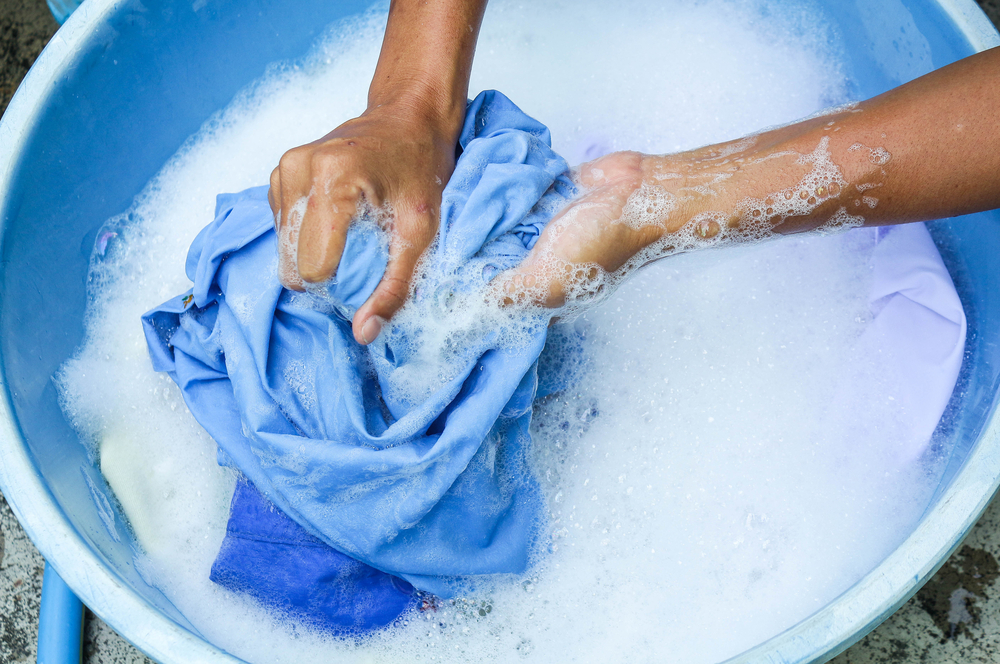All it takes is getting a little bit carried away with your current art project, and the next thing you know, your favorite shirt is covered in paint. Before you write it off as a lost cause however, you should know that there are many effective ways to remove paint from your clothing, no matter the type of paint and how long it has been there.
In this article, we will discuss everything you need to know about how to remove paint from clothing and leave you some tips for preventing paint stains in the first place.
Removing Different Types of Paint
There are many different types of paint and many different types of clothing that can get stained with paint. This can create a lot of variability when it comes to removing paint from your clothing.
In order to get the best results time after time, it is important to understand the differences in how to remove different types of paint and how to treat varying fabrics. It is important to keep in mind that spot tests should be performed on small areas of the clothing you are attempting to clean before you apply any removal method all over it; this prevents damage and further staining or ruining of clothes. Delicate fabrics such as silk and wool may fare better being taken to a professional in order to be cleaned.
Most of the methods we discuss below can be used on all types of fabrics, except for dry clean only clothing or extremely delicate fabrics.
Materials You Will Need
For these removal processes to work, you will need to have the proper materials. Depending on the method you are using, this includes paint thinner, cotton balls, sponges, rubbing alcohol, and an instrument or butter knife to scrape with. Having easy access to a washing machine and tumble dryer is also helpful.
Removing Water-Based Paints
Water-based paints are one of the easiest paint types to remove; water-based paints are also sometimes referred to as latex-based paints and are a very environmentally-friendly painting option.
To start the removal process, scrape as much paint as possible off of the clothing. You can use a butter knife or a plastic spoon for this. After the excess paint is remover, turn the item inside out and run cool or warm water on the other side of the stain.
Turn the item back the right way and mix one cup of cool water and a tablespoon of dish soap together. Use a cloth, sponge, or cotton pad and blot at the paint stain with this solution. You can repeat the running water and blotting steps two or three times until the stain is removed.
If the stain is extra stubborn, complete the steps above and then blot at it with rubbing alcohol on a cotton pad until the stain is gone. You can then wash the clothing in cool water and either air dry or tumble dry on a cooler air setting.
Removing Oil-Based Paints
Oil-based paints have a tendency to settle into clothing, making it hard to fully remove the stain. When treating oil-based paint stains on clothing, try to address the issue as fast as possible to prevent any kind of extra difficulty with removal.
Most oil-based paint stains will need to be removed with the help of a paint thinner or turpentine. You should be completing this process outside or in a well-ventilated area, because extended exposure to the fumes can be harmful.
Once you are outside, scrape any excess paint off of the clothing. Turn the item inside out and place paper towels on the inside of it to prevent any bleed-through of paint thinner or the stain itself.
Take a cotton ball or a cloth and put a small amount of paint thinner or turpentine on it. Blot this against the paint stain, switching between the front and back side of the clothing to saturate the stain from both sides.
After the stain is mostly gone, place a small amount of rubbing alcohol onto the stain and take a toothbrush or other soft brush, and scrub at the stain. This will remove any lingering color and residue.
As soon as the stain is gone, wash the clothing in cool water and tumble dry. Make sure not to dry the clothing with heat if there is any trace of the stain, and avoid using paint thinner or turpentine on synthetic and delicate fabrics, as it will break them down.
Removing Acrylic Paints
Acrylic paint stains are removed similarly to water-based paint stains. You will first need to scrape off any excess paint, turn the clothing inside out, and rinse the stain with cool or warm water. After this, blot with a mixture of cool water and a tablespoon of dish soap.
From this point, you can add a small amount of rubbing alcohol to the stain and rub it in gently with a cloth or a toothbrush until the stain lifts out of the clothing completely. With acrylic paints, you can also use various brush cleaners. Add a small amount to the stain and then scrub with a cloth before rinsing the clothing with cool water.
After the stain is removed, wash the clothing in cool or warm water and air dry or tumble dry.
Removing Spray Paints
How you go about removing spray paints depends on if the paint is oil or water-based; check the back of the spray paint can to find out this information. Once you have determined the type, you can follow the according method listed above to remove the stain.
Keep in mind that spray paint can be exceptionally stubborn. You may need to repeat the blotting and rinsing process multiple times to completely remove the paint; use a dry cloth between attempts to scrub at the stain and dislodge it further for easy removal.
You can wash your clothing with cool water and tumble dry only after the stain has been completely removed.
Removing Fabric Paints
Fabric paint is designed to sink into fabric and not wash out. The trick to removing fabric paint is to not use any heat on it whatsoever. Heat causes the paint to sink into the fabric, making complete removal almost impossible.
For this method, first scrape off any excess paint with a plastic spoon or a butter knife. Wash the clothing in the machine with cold water and detergent. Once you remove the item, assess the stain. If it is still there, you can apply rubbing alcohol to it.
Let the rubbing alcohol sit on the stain for 10 to 15 minutes without agitating it. Use a dry cloth to blot at the stain, lightly scrubbing to remove it. If the stain persists, apply another round of rubbing alcohol.
Once the stain is completely removed, wash the clothing in cold water with detergent, and then tumble or air dry it.
Removing Dried Paint
If you accidentally washed and dried your clothes without realizing they were still stained, you may be wondering if there is anything you can do now. Fortunately, dried paint stains can also be removed.
Scrap off the dry paint as much as possible. Use a butter knife for this, but be careful you don’t damage the fabric. Add rubbing alcohol on top of the stain and allow it to sink in for a few minutes.
Take a cloth or toothbrush and scrub at the stain, fully saturating it with rubbing alcohol and loosening up the stain. Once you’ve removed it as much as possible, run the clothing under warm to hot water. Hot water will help left the stain now that it is dried on.
You can repeat this process two to three times until the stain is removed, and then wash and tumble dry the clothing as normal.

Home Remedies for Clothing Paint Removal
These home remedies can be substituted in a pinch if you don’t have any rubbing alcohol or other detergents laying around, but need to deal with a paint stain as soon as possible.
Baking Soda and Vinegar
As you may have learned throughout your time in school, baking soda and vinegar cause a reaction when combined. You can use this to your advantage, because they are also fantastic at removing stains and cleaning various household items.
Once you’ve scraped off the extra paint, sprinkle baking soda on top of fresh stains, allowing it to absorb into the clothing. You can then add a few drops of vinegar, allowing the baking soda to foam up before scrubbing the stain with a toothbrush or a cleaning cloth.
After you’ve scrubbed at the stain, rinse it with cool water and follow up by blotting with a detergent and cool water mixture if the stain is still there.
Keep in mind that baking soda and vinegar might damage the clothing, so you shouldn’t use it on delicate items, and you should perform a spot test on a small area of the clothing in question before use.
Nail Polish Remover
If you don’t have any rubbing alcohol in your home, nail polish remover makes a perfect substitution. Simply use it exactly how you would rubbing alcohol in any of the paint stain removal methods we mentioned above to get great results.
Preventing Paint Stains
Now that you understand how to remove paint stains from your clothing, you may want to consider taking steps to avoid paint stains in the future.
Make an effort to not wear your favorite clothing items when painting, especially if they are made of a delicate fabric or a dry clean only item, as these are much harder to remove paint stains from. You can also invest in a painter’s apron if you are a frequent DIY painter, as this will help you protect your clothes as much as possible.
It is also a good idea to set aside an outfit just for painting if you are frequently painting homes or completing other DIY projects that require getting dirty. A dedicated set of paint clothes can save you the trouble of having to remove small paint stains from multiple clothing items, because the stains will all be on one dedicated outfit.

Refreshing Your Paint-Stained Clothes
After spending a relaxing afternoon painting or working on a DIY project, it can be annoying to realize that you’ve accidentally stained your favorite outfit with paint. Before you consider the clothes a loss, remember that there are many easy ways to remove paint stains from clothing. All you need is a little bit of patience and scrubbing, and your clothes should be free of paint stains in no time at all.
